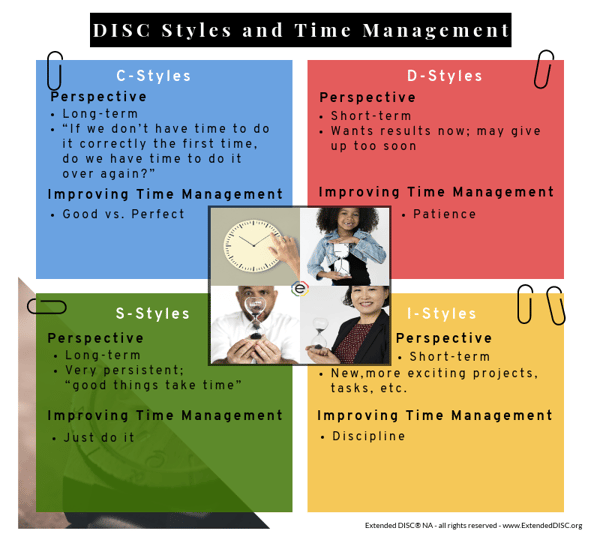Everyone wants to manage their time better. DISC helps increase our self-awareness by showing how we prefer to get things done. Once we are more aware of how we tend to do things, we can focus on making adjustments to be more productive.

How we manage time has a huge impact on our stress level. When we are able to manage time better we feel less stressed and more comfortable. Ultimately, what it boils down to is our own self-awareness. We all have different ways of managing our time and of doing things.
Our unique views of time management
Our hard-wired DISC style does not explain everything about our views on time management. Our beliefs impact how we view time in general and how we view time management. For example, many of us have heard the saying, "time is money". There are others who believe time is about enjoying every moment. Our culture also impacts how we view time. What country and region we live in impacts our attitudes and values about time. There are some places where meetings are scheduled for 10:00 a.m. and expected to start on time. On the other hand, there are other places where meetings have a start time of "roughly 10:00 a.m."
We judge ourselves based on our intention, but we judge others based on their observed behaviors. For example, we scheduled a meeting at 10:00 a.m. with the expectation that it will start on time, and someone shows up late. We may see that as being disrespectful of others, but the person showing up late had to finish up a few things and did not view being late as disrespectful.
How we prefer to do things
How do we complete tasks and approach projects and roles? Understanding how DISC styles do things helps us better manage our time and stress. D-styles are results-oriented and want to get started and do it right now. I-styles also want to get started, but will get people involved and excited about it. S-styles prefer to have a clear step-by-step plan so they are most likely able to get things done and not let others down. C-styles want to do things right, no matter how long it takes.

D-styles and Time Management
D-styles are not afraid of jumping head first into the unknown. They want to start as soon as possible so tasks get done and they can move on. Non-essential details are wisely ignored or mistakenly overlooked. They also tend to have short attention spans, which can cause them to give up on a task when they are not seeing results quick enough. Ideas often take time to develop and D-styles get frustrated with the time it can take to generate ideas. Their lack of planning and rush to get things done quickly can result in mistakes and even completion of the task. D-styles multi-task, and may not realize the wasted time it takes to move from one project to another.
I-styles and Time Management
I-styles are excited and ready to go. They excel at building enthusiasm around them and getting others involved. Their optimism helps them approach tasks with a positive attitude, but it can also cause them to overcommit or overestimate their ability to accomplish tasks in a timely manner. I-styles are good at ignoring the non-essentials. They can also get easily side-tracked and disorganized. Follow-through and follow-up are behaviors that may not come naturally to the I-style. I-styles approach to time tends to be short-term with newer and more exciting projects to take on, even before they complete the current one.
S-styles and time management

The S-styles are slower to get started, unlike the headfirst approach of the D-styles and I-styles. S-styles want to complete the task by sticking to a plan. However, before starting the task, they want clearly laid out step-by-step instructions. Guidance and support are essential to getting things done. They remain focused and thrive on routine tasks. Since they plan each step, they can often overestimate how much time it actually takes to complete the task. Their long-term, yet persistent approach to getting things done, can get derailed when the unexpected happens.
C-styles and time management
C-styles approach tasks with an overriding desire to do it perfectly, without mistakes. They are highly disciplined and take a systematic approach to doing things. However, their attention to details and finding every mistake can cause the C-style to get bogged down and loose track of time. They feel the need to double-check and triple-check everything. C-styles prefer to focus on a long-term approach to getting things done. They want to take the time to get it right the first time. If it is not perfect, they may ask to do it over again.
How to Use Extended DISC assessments in time management

One of the strengths of the DISC assessment is we can reprocess the DISC results into specific and relevant reports. The specific information can help identify the person's natural style and how they tend to manage time and how they approach tasks. Once we have better self-awareness, then can make decisions on how we can better manage our time. Managers can also use the information to help distribute responsibilities, coach, and develop skills in their employees.
Tips for more effective time management
If we want to improve our time management skills we need to push outside our comfort zones and make behavioral changes. Short term focused D-styles need to become more patient. Starting quickly is not always the best approach when tasks and ideas need to be developed. Slowing down and allowing time for fellow team members to get onboard will insure a higher rate of success. I-styles need to focus on discipline by prioritizing what is more important and sticking to it. They should not allow more exciting and new projects to distract them. S-styles need to just do it by getting started. The time spent on planning is sometimes less effective than just doing it. C-styles don't always need to aim for perfection and sometimes good enough really is.
